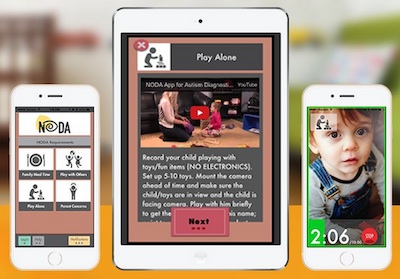 Diagnosing autism remotely, from videos taken with a parent’s smartphone, was found to be 87 percent as accurate as in-person diagnosis in a small preliminary study funded by an NIH grant.
Diagnosing autism remotely, from videos taken with a parent’s smartphone, was found to be 87 percent as accurate as in-person diagnosis in a small preliminary study funded by an NIH grant.
The NODA system (Naturalistic Observation Diagnosis Assessment) is an app developed by Boise, Idaho-based Behavior Imaging Solutions in partnership with Georgia Tech and Southwest Autism Research and Resource Center (SARRC) in Phoenix, Arizona. Agata Rozga, a researcher at Georgia Tech who has conducted some of the research on the NODA platform, presented the technology at a showcase of companies incubated at the Interoperability & Integration Innovation Lab (I3L) at Georgia Tech.
“The problem is that despite all the increased awareness of autism, we’re still seeing pretty significant delays between when parents first notice that there’s something off about their child and when we’re actually able to get them into the office for a diagnosis,” she said. “And the kids are missing out on treatment during that early crucial time.”
The app instructs patients to take 10-minute videos of a child in thee scenarios: meal times, playing alone, and playing with others. A fourth video slot is for parents to record their own concerns and observations. It also guides parents through the process, helping them to create videos that will be maximally helpful to a clinician assessor.
“You can’t just ask a parent to record,” Rozga said. “You need to think about what does the clinician need to see to provide a proper diagnostic assessment. So part of the work went into thinking about what are the right scenarios to record? What are the right instructions to parents about how to set up the video and what to do during the recording?”
Once they’re satisfied with the video, they can upload it to the clinician. The backend lets physicians tag time stamps in the video with DSM criteria for autism, make notes to the side of the video, and facilitate a quantitative diagnosis process.
The intervention is designed to address the problem of long waiting lists for parents to get their child screened for autism, but it also has implications for parents in rural areas far away from a specialist. In some ways the videos might have an advantage over a clinical assessment, since they show the child immersed in his or her everyday life.
The clinical study included 32 children identified as possibly autistic, 9 neurotypical children, and 6 children with non-autism concerns. Parents followed the NODA protocol but also took the child to an in-person clinician who was blinded to the NODA process. Eighty-seven percent of the diagnoses matched up, Rozga said, and there were more false positives than false negatives among those that didn’t match.
The company is currently recruiting for a large scale pilot in Arizona, set to begin January 1st.













